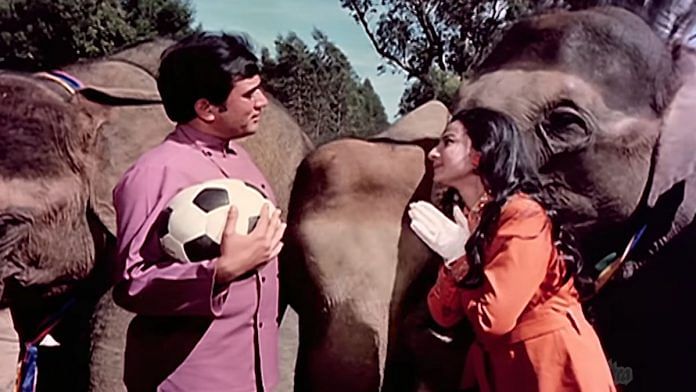Haathi Mere Saathi (1971) remains unmatched in how it bridged the emotional world of animals and humans in Hindi cinema.
While many Bollywood films have featured pets or jungle adventures, like Entertainment (2014) and Dil Dhadakne Do (2015), none have forged such a deep, soul-stirring bond between man and animal as this Rajesh Khanna classic.
Directed by MA Thirumugam and produced by Sandow MMA Chinnappa Devar, the film remains one of the most iconic works of the 1970s in Hindi cinema.
The film centres on Raju (played by Rajesh Khanna), who is inseparable from his four elephants. More than just companions, these elephants are his family, with Ramu being the closest of the four.
Unlike most films, like Hum Aapke Hain Koun (1994), Aankhen (1993), and Chillar Party (2011), which reduce animals to comic props or background characters, Haathi Mere Saathi places them at the heart of the narrative, making them essential to both the plot and emotion.
One unforgettable moment in the film captures the human-animal bond perfectly: when Raju falls seriously ill, the elephants rush to his aid, physically dragging a doctor to his bedside.
As the doctor leaves, he tells them to trust in God.
What follows is both touching and extraordinary. In their own way, the elephants perform a ritual of worship. They sprinkle water with their trunks on Raju, place a garland on him, and ring bells at a temple, praying for his recovery.
An emotional triangle
Rajesh Khanna brings a rare sensitivity to the character of Raju. His interactions with the elephants exude authenticity—so much so that one forgets he’s acting.
His childlike joy, fierce protectiveness, and moments of internal conflict are all portrayed with great emotional depth.
In one of the scenes that defines the film’s moral compass, Raju chooses to give up his bungalow rather than sell his elephants to a wealthy man. His dialogue, “Is duniya mein do tang wala janwar sabse khatarnak hai”. (The most dangerous animal in this world is the two-legged one), cuts deep.
As the story unfolds, Raju falls in love with Tanu (Tanuja Samarth). At first, she shares his affection for the elephants, but marriage brings a shift.
Her warmth turns into resentment, especially after they have a child—fearing the animals pose a danger.
This emotional shift becomes the heart of the film’s conflict: Raju is caught between two loyalties—the bond he shares with his elephants, and his growing responsibilities as a husband and father.
This tension explodes in a confrontation when Tanu gives Raju an ultimatum, “Either those animals will live in this house or me and my son will.”
In a heart-breaking climax, Ramu the elephant sacrifices himself to save Raju. The scene unfolds slowly, each moment soaked in grief, as Raju cradles Ramu’s head, sobbing uncontrollably.
Raju’s entire journey is one of giving—to his elephants, to his wife, to society.
The elephants, especially Ramu, mirror this, becoming symbols of divine love and unconditional loyalty.
Also read: ‘Love Story’ launched Kumar Gaurav as teen heartthrob of 1980s India. He was a nepo baby
Box office hit
Laxmikant-Pyarelal’s music is one of the strongest pillars of the movie. Each song is embedded with emotion, whether it’s the playful Duniya Mein Rehna Hai To Kaam Kar Pyaare or the heartbreaking lullaby Nafrat Ki Duniya Ko Chhod Ke, which Raju sings while bidding his friend final goodbye.
But the song that sets the tone of the film is Chal Chal Chal Mere Saathi by Kishore Kumar. It establishes the relationship between Raju and the elephants in the most poetic way. The lyrics—Tu yaaron ka yaar hai, kitanaa wafaadaar hai..Jhuuthaa hai saaraa jahaan, sacha tera pyaar hai…Tu pagalaa, na badalaa….Tu pagalaa, na badalaa….SarI duniya gayii hai badal, chal…Chal chal chal—show how Raju trusts the elephants more than any human relationship.
The songs don’t feel inserted, but flow with the narrative, providing both exposition and emotional context.
MA Thirumugam deserves praise for directing a film that required coordinating with large animals and child actors, and included dramatic emotional sequences—and making it all work seamlessly.
Special effects are minimal but effective, with practical action and animal training doing most of the work.
Cinematographer KS Prasad captures the contrast between the open-hearted wilderness and the confined world of humans beautifully.
Haathi Mere Saathi was a massive box office hit upon its release in 1971.
It is credited with sparking a trend of animal-centric films in Indian cinema.
Even today, animal lovers see the movie as a cinematic expression of their deepest emotions.
At a time when films often rely on CGI to create emotion, Haathi Mere Saathi reminds us that true storytelling lies in authenticity—and in the simple idea that love, in all its forms, is sacred.
Views are personal.
(Edited by Aamaan Alam Khan)






